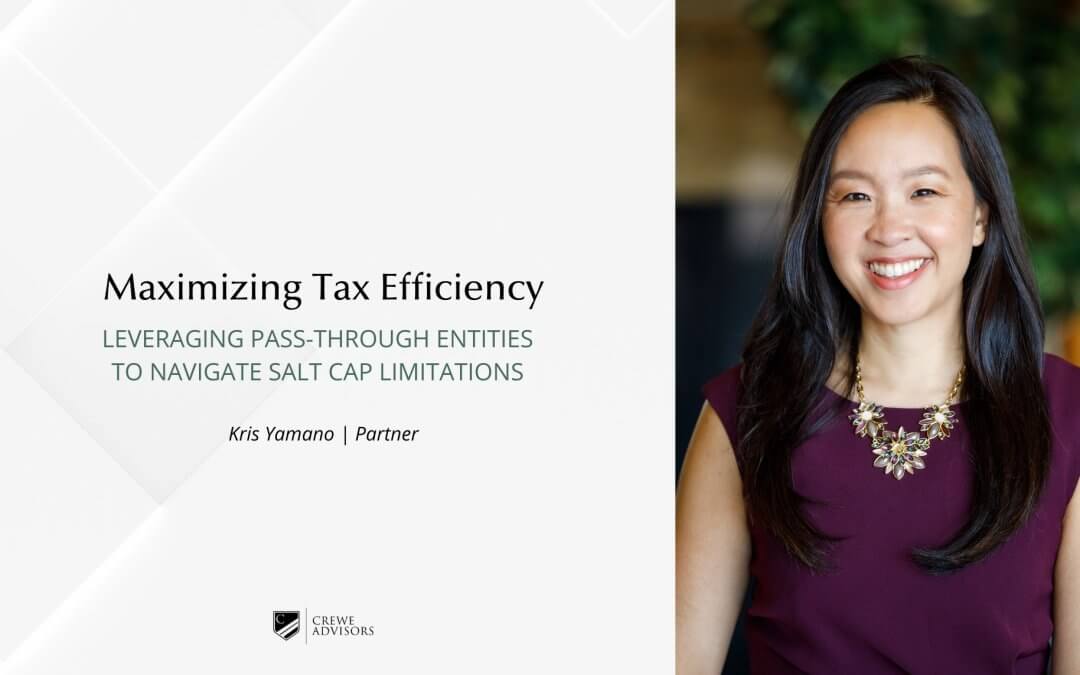For many business owners, an exit from the successful venture they have dedicated so much of their time and energy to can be overwhelming. Entrepreneurs work tirelessly to ensure the vision for their business comes to life and often have a hard time navigating the complexities leading up to this moment. An exit from the business not only represents the culmination of years of hard work, dedication and sacrifice but also marks the beginning of a new chapter in their lives – one that requires careful attention and diligent planning.
The process of exiting a business is far more than just a financial transaction; it is a complex balance of personal goals, strategic decision-making, tax and legal complexities and wealth preservation. In this whitepaper, we dive into the various aspects of exit planning – highlighting critical considerations and some strategies that may be used to ensure a successful transition. By taking a holistic approach that contemplates both the personal and business components of the transaction, business owners may be armed with the knowledge and tools they need to move forward on their journey with confidence, ensuring the legacy they’ve built over their lifetime is sustainable for generations to come.
Overview of Pre-Liquidity Planning
At its core, pre-liquidity planning is simply the proactive process taken by a business owner before the sale or transfer of their business, intended to help optimize the outcome of the transaction. Careful consideration of personal and business objectives, comprehensive assessment of the business and personal financial situation and an analysis of the various strategies available is required to meet the goals of pre-liquidity planning which include mitigating risk, minimizing tax, preserving wealth and aligning the transaction with the business owner’s long-term financial goals.
Understanding Your Exit Options – Balancing Ownership/Control & Liquidity
For many, exiting a business is like a complex maze where each path you take offers a unique set of characteristics. One of the biggest considerations will be determining the balance between maintaining ownership/control of the business and generating sufficient liquidity for the owner. Below is a summary of some of the options available in order of highest to lowest control (or conversely lowest to highest liquidity immediately available to the owner.
EXIT OPTION
Transfer to Family
Ownership or Control of Business
High
Liquidity for Seller
Potentially Limited/Low
Key Considerations
Preserves family legacy. Can be structured in a way to maximize tax advantages. The seller may need to finance the transfer, which may prevent an immediate payout. Seller must be willing to play an ongoing role until family members are deemed ready to take over.
Suitable For
Business owners who want to maintain the business in the family and are willing to commit the time and resources to prepare the next generation to allow for a smooth transition.
EXIT OPTION
Sale to Management / Key Employees
Ownership or Control of Business
Shared with Management/Key Employees. Moderate and decreases over time.
Liquidity for Seller
Moderate
Key Considerations
Gradual liquidity event (often structured as an installment sale) that incentivizes management and key employees and allows owner to stay involved. Can be seller financed or debt financed.
Suitable For
Companies with a strong leadership team whose owner wants to ensure continuity of the business and is willing to take a gradual payout.
EXIT OPTION
Sale to a Strategic or Other 3rd Party
Ownership or Control of Business
Low to Moderate
Liquidity for Seller
High
Key Considerations
Can broaden market reach. Complete transfer of operational control. Possible due diligence issues. Complex negotiations.
Suitable For
Business owner who has primed the company for sale, wants immediate liquidity and is ready to move away from running the business.
Preparing for Transition
Assessing the current state of the business helps lay the foundation for a successful transition. Working with a good investment banker who specializes in sell-side advisory is key in understanding the company’s financial health and performance as well as market position and competition.
The earlier a business owner ponders an exit (up to several years before a planned exit), the better the potential outcome. A longer runway permits the owner to engage in effective planning on both the business and personal side.
Beyond business-specific preparations, identifying and understanding the owner’s personal goals is critical.
Tax Considerations
Effective pre-liquidity tax planning can significantly impact the net proceeds received by a business owner following a liquidity event. Understanding and managing tax liabilities is vital to maximizing the wealth generated in the transition. It is important to understand there are two distinct tax regimes that business owners face – the federal income tax, and the estate and gift tax. A good pre-liquidity analysis addresses both income and estate tax issues and considers strategies that can mitigate the overall tax burden and help business owners achieve their financial goals.
Income Tax Planning
Entity Structure: How the business is structured may have significant tax implications. Limited Liability Companies (LLCs), Partnerships and S-Corporations are pass-through entities in which individual owners report the income and losses from the business directly on their personal tax returns and no tax is assessed at the company level. In contrast, owners of a C-corporation may find themselves paying double tax upon exit from the business (but see below for discussion of the possible QSBS exclusion).
Structure of the Deal & Terms of the Sale
Stock vs. Asset Sale: All other things being equal, from a tax perspective, the seller of a business will prefer a stock sale over an asset sale because the gain on the sale of stock may receive preferential capital gains treatment subject to a maximum federal rate of 23.8% (including the 3.8% net investment income tax). In contrast, buyers will favor an asset sale (an itemized purchase of the company’s underlying assets) for both tax reasons (such as the ability to set a higher depreciable basis) and non-tax reasons (avoidance of future liabilities). Because an asset sale can result in a higher overall tax obligation for the seller, business owners looking to exit their business in an asset sale should consider that as a factor in their negotiations of purchase price.
Section 1202 Qualified Small Business Stock Capital Gains Exclusion: Applicable to some owners of qualified domestic C-corporations, the Sec 1202 gain exclusion could provide a huge tax benefit to business owners upon sale (up to 100% exclusion of federal capital gains tax or the option to roll and defer taxable gains through reinvestment in other QSBS entities) – see our Whitepaper ”Qualified Small Business Stock (QSBS) – An Overview and Company Qualifications” for additional details.
Cash Sale: Although rare, an all-cash sale allows the business owner to receive a lump sum of cash in exchange for his or her full interest in the business. Gain from the sale (the excess in the sales price over the owner’s basis) will generally be recognized in the year of the transaction. In a cash sale, the timing of the transaction could prove highly relevant. A sale closing on 12/31 would require the seller to pay all taxes due by 4/15 of the following year. Pushing the close date out to 1/01 of the following year would give the seller an additional year of liquidity before having to pay any tax obligations from the sale.
Installment Sale/Seller-Financed: Riskier to the seller than an all-cash sale, an installment sale is more common and very often considered in intra-family transitions. Installment sale treatment occurs when at least one payment is made after the year of the sale (instead of all proceeds being received as a lump sum in the year of sale). Although gain from the sale can be deferred over the course of the note term, an analysis should be run to ensure the business is stable enough (with sufficient cash flow available) to service the installment payments. Additional care should be taken (especially in the case of an intra-family transfer) that an adequate interest rate is being charged on the portion of the note the seller is financing to avoid any gift tax issues.
Earnout: With this structure, the seller receives a portion of the purchase price immediately, and the remainder (the earn out) is received over the course of several years, contingent on the business meeting some agree-upon performance milestones. Earnout structures are often used to bridge the gap between what the seller believes the business value is and what the buyer is willing to pay for it. Earnouts may be risky to the seller as he or she may be relinquishing control of the business (and future performance as a result).
Equity Rollover: With an equity rollover, the seller reinvests a portion of the proceeds from the sale of the business into the company the buyer has used to acquire their business, thereby retaining a minority stake in the new business. An equity rollover enables the seller to take some chips off the table (and garner some immediate liquidity) while also providing an opportunity to get what is often referred to as “a second bite of the apple” (the ability to benefit from an increase in the value of the company when it is sold in the future).
State Income Tax Planning:
Non-Grantor Trusts: For those individuals living in states with a high income tax rate, an Incomplete Gift Non-Grantor (ING) Trust created in a state with no income tax (like the Nevada Incomplete Gift Non-Grantor Trust, or NING) may help reduce a significant state income tax liability. ING trusts are specifically designed to reduce or eliminate state income taxes by shifting the tax base of its asset to a state with no income tax and often include the following features:
irrevocable
non-grantor (meaning the trust is treated as a separate taxpayer and responsible for its own federal and state income taxes)
transfers to INGs are incomplete for gift tax purposes) so they are included in the grantor’s estate (and therefore eligible for a step-up in basis upon grantor’s death)
grantor is an allowed beneficiary of the trust during his/her lifetime (can still utilize the assets of the trust).
Charitable Planning: For business owners that have philanthropic intent, the benefits of making a gift to a charitable vehicle well in advance of a sale of their entity could be multi-faceted. If the business is sold after the owner has donated a portion of it to charity, the owner’s gain on the sale may be mitigated (or even eliminated). In addition, the owner may take an immediate charitable income tax deduction on the gift and has also made a significant contribution to a charity of his or her choice.
Charitable Remainder Trust (CRT): A CRT is a “split interest” vehicle that may benefit both charitable and non-charitable beneficiaries. A business owner can gift appreciated assets (such as an interest in their business) to the CRT and take a partial tax deduction at the time of the gift. The deduction amount will be based on how the trust is set up including the terms of the trust (length, payout amounts), the amount expected to be left for charity and the current IRS interest rates that project the growth of the trust assets. The business owner (or their assigned beneficiaries) may receive an income stream over their lifetime or a period of years. The annual annuity must be at least 5% (but no more than 50%) of the trust’s assets. The remaining assets in the trust are distributed to one or more charitable beneficiaries at the end of the trust term. The trust itself does not recognize capital gains on the portion of the business it owns upon sale. Instead, the owner effectively defers capital gains until distributions (annuity payments) from the trust are received.
Donor Advised Funds (DAFs): If the business owner does not need or want an income stream after a business exit, he or she can instead choose to gift a portion of their business interest to a Donor Advised Fund. A DAF enables the owner to receive an immediate charitable tax deduction (equal to the fair market value of the stock on the date it is contributed) and creates a fund from which the owner can recommend grants to qualified charities in future years. A DAF may provide a business owner the opportunity to create a low-cost vehicle for charitable giving while receiving the maximum tax deduction available and avoiding excise taxes or other restrictions. DAFs may extend beyond the life of the business owner and permit successor advisors (children, grandchildren, etc.) to actively participate in the grant-recommending process. Assets that are gifted to a DAF are completely removed from the donor’s estate.
Estate and Gift Tax Planning – Before a sale of the business is seriously considered, an owner who is expected to have a taxable estate should consider the following strategies to alleviate a potentially substantial estate tax liability.
Sale to an Intentionally Defective Grantor Trust (IDGT): A business owner may set up this type of irrevocable trust to mitigate the challenge that arises when a business of substantial value continues to grow (creating a future estate tax liability issue). An IDGT is a special type of trust that enables the business owner to treat the trust as disregarded for income tax purposes (i.e. “defective” for income tax purposes), while ensuring the assets belonging to the trust are excluded from his/her estate for estate tax purposes. Using this vehicle, a business owner would fund the trust with a gift of “seed money” (usually at least 10% of the value of the asset to be transferred). Immediately thereafter, the owner may sell a portion of the business in exchange for a promissory note. There are no income tax consequences upon the sale since the trust is “defective” for income tax purposes. The business owner would thereafter receive annual payments from the IDGT in satisfaction of the note until the end of the term. For estate tax purposes, any assets and (more importantly) future appreciation of those assets are not included in the grantor’s estate.
Grantor Retained Annuity Trust (GRAT): A popular alternative to the IDGT, a GRAT enables a business owner to gift (not sell) a portion of the business to a trust and then receive fixed annual payments for a specified term of years, while using little, if any, of their federal gift and estate tax exemption amounts. At the end of the term, the remaining trust assets (including any appreciation) pass to the beneficiaries either outright or in trust. As with the IDGT, a GRAT is irrevocable and so long as the business owner outlives the trust term, all assets transferred will be removed from the grantor’s estate.
Charitable Lead Trust (CLT): For business owners with charitable intent and no need to receive a future income stream from the portion of the business gifted, a CLT may be a good potential solution. CLTs provide a way for business owners to provide financial support to a charity (or several) for a period of years with the remaining assets ultimately passing to family members or other beneficiaries. Using this strategy, a business owner could receive an immediate charitable income tax deduction, avoid capital gains taxes upon sale and remove assets from their estate. Unlike a charitable remainder trust, a charitable lead trust is not tax-exempt and therefore pays tax on its income.
Wealth Management and Financial Planning
Comprehensive and holistic financial planning should be considered a key component of pre-liquidity planning for business owners. It allows the owners to stress-test various assumptions about what the sale of the business could mean to them and their families and enable them to better create appropriate strategies for preserving and growing their personal wealth immediately following the transaction.
Retirement planning and financial goals: For business owners, retirement planning can be tricky, but is an important part of pre-liquidity planning. Taking the time to define your financial goals, assess your current retirement savings and establish a timeline for achieving your personal financial objectives is critical to your financial success post-transaction. Well in advance of a business exit, diversification of assets (outside of the business) provides a good foundation for future retirement. Reviewing and implementing the appropriate retirement plan for the business (i.e. 401(k), SEP IRA, SIMPLE IRA, etc.) is an important component of a smooth transition for business owners.
Investment strategies: The importance of developing a personal investment portfolio and an investment strategy tailored to your risk tolerance, financial goals and time horizon cannot be understated. Having grown the most substantial portion of your wealth in a concentrated position, planning for diversification across various asset classes post-transaction will help mitigate risk. Pre-liquidity planning on this front often means rebalancing investments early to ensure they align with post-liquidity goals.
Risk management (insurance): Evaluating your insurance coverage and entity structure (for any other investments) post-transaction will enable you to protect against the consequences of unexpected events. A thorough review of life, disability, long-term care, and liability coverage is crucial. Determine if your current coverage aligns with your immediate and anticipated financial needs, especially in light of a potential liquidity event. Insurance can provide another layer of protection for you and your family.
The importance of assembling the appropriate advisory team to help you manage all facets of the pre-liquidity planning process cannot be underscored enough. A transition team should include your wealth advisors, legal experts, investment bankers and tax professionals that can provide guidance on both the business and personal implications of a future transaction. At Crewe, we are uniquely positioned to help you work through both the business and personal pre-liquidity planning considerations every business owner should evaluate prior to a major transition.










